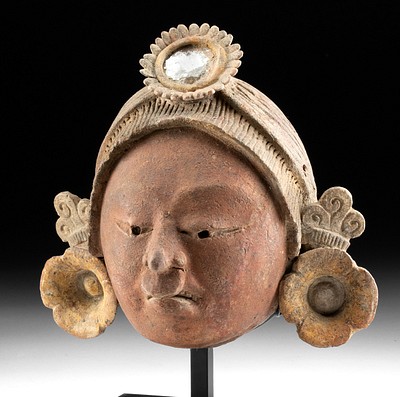Inca Chucu Polychrome Plaque w/ Humans & Animals
Lot 108
About Seller
Artemis Gallery
686 S Taylor Ave, Ste 106
Louisville, CO 80027
United States
Selling antiquities, ancient and ethnographic art online since 1993, Artemis Gallery specializes in Classical Antiquities (Egyptian, Greek, Roman, Near Eastern), Asian, Pre-Columbian, African / Tribal / Oceanographic art. Our extensive inventory includes pottery, stone, metal, wood, glass and textil...Read more
Estimate:
$3,600 - $5,400
Absentee vs Live bid
Two ways to bid:
- Leave a max absentee bid and the platform will bid on your behalf up to your maximum bid during the live auction.
- Bid live during the auction and your bids will be submitted real-time to the auctioneer.
Bid Increments
| Price | Bid Increment |
|---|---|
| $0 | $25 |
| $300 | $50 |
| $1,000 | $100 |
| $2,000 | $250 |
| $5,000 | $500 |
| $10,000 | $1,000 |
| $20,000 | $2,500 |
| $50,000 | $5,000 |
| $100,000 | $10,000 |
| $200,000 | $20,000 |
About Auction
By Artemis Gallery
Jul 14, 2022
Set Reminder
2022-07-14 10:00:00
2022-07-14 10:00:00
America/New_York
Bidsquare
Bidsquare : Exceptional Antiquities Ethnographica Fine Art
https://www.bidsquare.com/auctions/artemis-gallery/exceptional-antiquities-ethnographica-fine-art-9692
Museum-worthy examples of classical antiquities (Egyptian, Greek, Roman, Near Eastern), Viking, Far East / Asian, Pre-Columbian, African / Tribal, Oceanic, Native American, Spanish Colonial, Fossils, Ancient Jewelry, Fine / Visual Arts, so much more! Artemis Gallery info@artemisgallery.com
Museum-worthy examples of classical antiquities (Egyptian, Greek, Roman, Near Eastern), Viking, Far East / Asian, Pre-Columbian, African / Tribal, Oceanic, Native American, Spanish Colonial, Fossils, Ancient Jewelry, Fine / Visual Arts, so much more! Artemis Gallery info@artemisgallery.com
- Lot Description
Pre-Columbian, southern Peru, Inca hinterlands (Chucu), ca. 1000 to 1500 CE. A beautiful ceramic plaque with irregular edges, painted with a vibrant and powerful visual ordering of space with rows of painted figures and animals, reduced to highly simplified, linear forms. Arranged alternating with bands of dot patterns, perhaps a representation of crops and agricultural land. Beautiful white, green, red, and sparkling silver/grey pigment (made from mica) colors the buff surface of the plaque, creating the iconography. Their minimalist form resembles rock art. Plaques like this were placed as offerings to Pacha Mama and Pacha Papa (Mother and Father Earth) to insure health among the livestock and among human inhabitants of the clan. Size: 11" L x 10.5" W (27.9 cm x 26.7 cm)
These plaques were made by smashing large vessels and painting the fragments, and the blank verso has a slightly outturned edge, perhaps the rim area. Painted plaques have been discovered in a number of different contexts: beneath wall foundations, in graves, with animal sacrifices, and cached in prominent places in the landscape, like in springs, rock hollows, and atop hills. They are often discovered in pairs, with the painted surfaces placed so that they are facing each other, sometimes wrapped in leaves or even gold sheet. Although the tablet tradition began centuries before, the time period that this one comes from represents the height of the artform, and corresponds to an intensification of agriculture, the rise of interregional trade networks, and the ascendancy of certain important confederations of clans. Into this potent mix, the Inca expanded into the region and the tablet tradition abruptly ended. It seems likely that the Inca, who colonized regions in part by sponsoring local ritual activities, outlawed the creation of religious tablets like this because they saw them as a threat to their trade in sacrificial alpacas, corn beer, and cloth.
Provenance: private New York, New York, USA collection; ex-B.G. Malone collection, Texas, USA, before 1970
All items legal to buy/sell under U.S. Statute covering cultural patrimony Code 2600, CHAPTER 14, and are guaranteed to be as described or your money back.
A Certificate of Authenticity will accompany all winning bids.
PLEASE NOTE: Due to recent increases of shipments being seized by Australian & German customs (even for items with pre-UNESCO provenance), we will no longer ship most antiquities and ancient Chinese art to Australia & Germany. For categories of items that are acceptable to ship to Australia or Germany, please contact us directly or work with your local customs brokerage firm.
Display stands not described as included/custom in the item description are for photography purposes only and will not be included with the item upon shipping.
#172615Overall good with some wear commensurate with age. Fading to pigments, but motifs are still visible and discernable.Condition
- Shipping Info
-
All shipping is handled in-house for your convenience. Your invoice from Artemis Gallery will include shipping calculation instructions. If in doubt, please inquire BEFORE bidding for estimated shipping costs for individual items.
-
- Buyer's Premium



 EUR
EUR CAD
CAD AUD
AUD GBP
GBP MXN
MXN HKD
HKD CNY
CNY MYR
MYR SEK
SEK SGD
SGD CHF
CHF THB
THB













